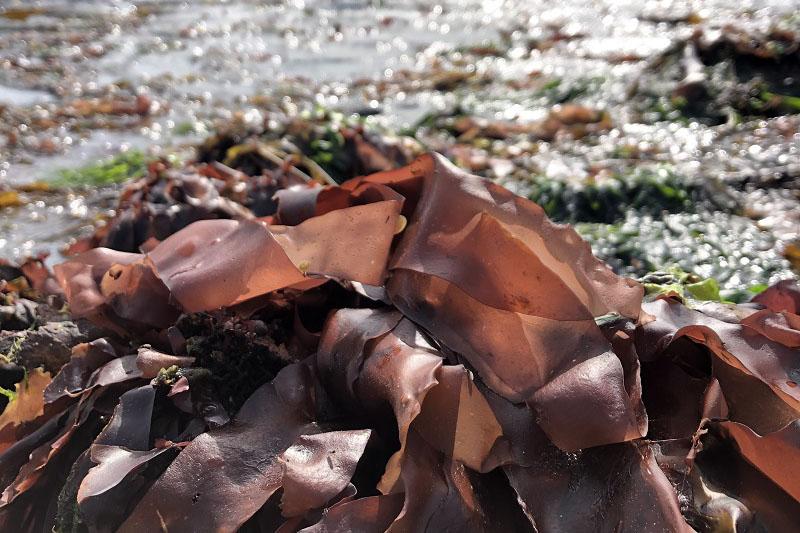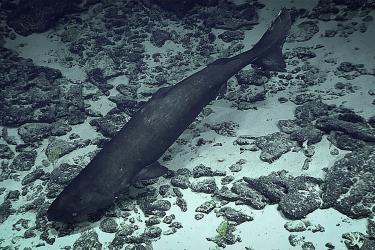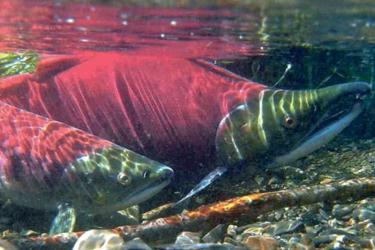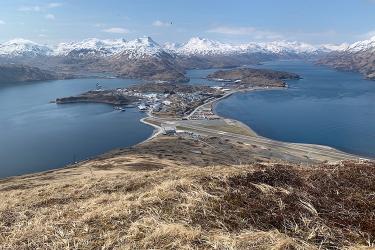Need for Land-Based Culture
Ḵ’aach’ or dulse is a traditionally important seaweed species that has been harvested in Southeast Alaska for millennia by the Tlingit and Haida peoples. Tribal members have expressed concern that this vibrant red algae may be threatened by climate change, nearshore contamination, and harvesting pressures. At the request of Justina Hotch, an educator in the Alaska Native community of Klukwan, NOAA’s Alaska Regional Aquaculture Program developed a small-scale tumble culture and curriculum to grow Ḵ’aach’ in a K-12 classroom in Klukwan. Curriculum and materials were also shared with 3rd and 4th graders in Juneau.
Grant to Prioritize Aquaculture Inclusivity
The project was awarded an International Call for Aquaculture Funds Diversity and Inclusion grant and is one of the first projects funded under this mechanism. NOAA provides numerous grants and federal assistance programs to promote sustainable aquaculture across the country. Aquaculture is one of the most efficient ways to produce protein (such as that found in dulse). It currently supplies more than 50 percent of all seafood eaten by humans.
Increasing diversity and inclusion in aquaculture strengthens traditional methods of cultivating marine life for food, while also teaching the care and handling of the seaweed. Including traditional ecological knowledge and practices bolsters the success of these projects while providing leadership within the community.
“A number of traditionally important seaweeds in Southeast Alaska have become harder to find, whether it's from changes in ocean conditions or other factors. Land-based culture methods provide an alternative, and bringing these methods into the classroom helps excite kids about the possibilities of seaweed aquaculture in our state,” said Alicia Bishop, NOAA’s Alaska Regional Aquaculture Coordinator.
Hands-on Education
The tumble culture was created using basic parts from a hardware store:
- Action packers
- Five-gallon buckets
- Smaller perforated tubing for bubbles
- A chiller
- PVC pipes
- Lights
- An air pump
With the addition of artificial seawater and nutrients, the tumble culture can mimic the marine environment. This allows dulse to be grown in the classroom—even those far from the ocean. The tumble cultures were constructed at the Alaska Fisheries Science Center Ted Stevens Marine Research Institute and then ferried over to Klukwan for use in the classroom. Students are responsible for the care and near-daily maintenance of the tanks which includes adding nutrients, changing the water, cleaning tanks and charting growth.
Students are working with Ms. Hotch to collect seaweed, clean it in freshwater, and fragment it for growth. Using artificial grow lights on a timer and maintaining the water at 10 degrees Celsius mimics the seaweed's ideal growing conditions.
The curriculum covers dulse lifecycle and structure, comparison of seaweed to terrestrial plants, and an art project creating bookmarks out of pressed seaweed (a classroom favorite).
This program provides a hands-on approach to learning about a culturally significant species through its care and cultivation. It brings together community knowledge and research to educate a new generation on a significant food source.
Sharing the Bounty
Prior to going up to Klukwan, NOAA researchers shared the seaweed curriculum with students in Juneau leading up to their Sea Exploration Week. Students loved getting to touch and feel different kinds of seaweed, and made extra seaweed bookmarks to share with their peers in Klukwan. The students in Klukwan collected and dried Ḵ’aach’ to share with community members. Ḵ’aach’ is a popular snack that can be dried on cookie sheets, or flash fried with sugar for a sweet or savory treat.
Traditions Inspired for the Classroom
Low tides in May provided an opportunity for students from Klukwan to collect the seaweed to bring back to the classroom. They also looked at various marine species while in the field, inspected different seaweeds under the microscope, and learned about traditional seaweed harvesting from elders. This field experience is a great foundation to introducing the cultural importance of Ḵ’aach’ as well as its significance as a subsistence food for Tlingit and Haida people.
The primary goal of the project is to grow Ḵ’aach’ for students. A secondary goal is to transfer the knowledge explored in the classroom to the Chilkat Indian Village and Chilkoot Indian Association for the eventual commercial aquaculture development and sale of the seaweed. Lead teacher Ms. Hotch set the core values of the program to align with stewardship of wild crops, community access to traditional foods for subsistence and ceremony, income generation, and youth education.
Dr. Jordan Hollarsmith, Alaska Fisheries Science Center Aquaculture Research Lead noted, “Community collaborations ensure that our research is addressing the diverse needs of the people throughout Alaska, while also giving us the opportunity to learn from people who have harvested these species for generations.”
The hope is that this aquaculture project with Alaska native and coastal communities will be adaptable to more classrooms. The success of the project will allow students to grow Ḵ’aach’ with or without access to ocean water. The program will reach even more diverse communities to learn about tumble culture methods while bolstering traditional knowledge and practices.









